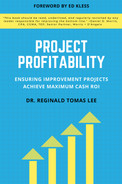I’d like to propose that companies unknowingly waste and lose billions of dollars annually on improvement projects such as IT solutions, Six-Sigma, lean, process improvement, and equipment-based improvements. It’s not to suggest these projects aren’t important or valuable, they just do not deliver on the promised savings. Consider the following.
Let’s say someone makes the following offer: invest $100 thousand on an improvement project for your organization, and the solution will yield $1 million in savings. The promise may be made by an outside consultant, or even someone who works for your organization—a manager trying to improve her department, for example, or a team of individuals looking to make a difference for the firm. The suggestion is that by eliminating waste, improving quality, or speeding up transactions, the solution makes the workforce 25 percent more efficient. This should, in theory, lead to cost reductions. For each person making $100 thousand that’s a $25 thousand savings per person per year. With 40 people in the department, that’s $1 million in one year, or $3 million in three years. That’s a pretty strong ROI (return on investment), right?
This is how these projects are often justified by those seeking the change and agreed on by those approving the change. We’ve all seen it and, in many cases, many of us have been responsible for it. I have seen it over and over again, as an engineer, a consultant, and as an academic, where huge value propositions are created to gain project approval, and then the fun begins. The team implements the project, and a very small portion of the savings are realized, sometimes off by an order of magnitude or more. An order of magnitude in the previous case would suggest $100 thousand being the savings versus $1 million. Why does this happen?
There are three primary reasons this happens. First, not all projects are capable of realizing financial returns. Many companies require financial justifications to hire consultants to do work, for example, but a consultant providing a company with a diagnosis of a problem or a way to fix it will not save anything. Creating a financial justification in this case does little good and lots of harm.
Second, the cost–benefit calculations are grossly inadequate. Take the previous example. What does the $25 thousand in savings represent? It’s not money, it’s a value placed on time. If the 40 people still work for the company at the same salary, not a single penny was saved. Most cost–benefit analyses are accounting based, and accounting costs and benefits such as those described earlier are not money, they’re value. Hence, one would have paid $100 thousand to make people more efficient, which is good, but the savings in cash will not occur. Cost– benefit analyses should be cash based. What was spent in cash and what was returned in cash. Most analyses are not as diligent about focusing on cash as they should be if the objective is to make money from the improvement project.
Finally, most companies focus on agreeing to, or actualizing the project. There is less diligence paid to the actual execution of the project for the purposes of realizing cash value. It’s the execution where the savings must occur. If the objective is cash savings, oftentimes, the improvement project itself will not create cash savings on its own. Instead, it enables managers to make decisions that will lead to cash savings. It’s up to the managers to make and act on the decisions, and for the organization to hold the managers accountable. If managers don’t make decisions that affect spending and benefit realization, the benefits will not happen.
I wrote this book to help companies and consultants avoid these issues. The emphasis is on the cash value of projects. As such, accounting costs are dismissed and replaced with a framework that focuses on cash value realization.
For Managers and Executives
This book will focus your teams on the steps and actions required to realize cash value for each of your improvement projects. It will also provide you with information to help you see when consultants and salespeople are trying to pull the wool over your eyes by promising huge savings you will never see.
This book will help you think through your solutions and understand why they generally won’t create cash value on its own. Knowing why, you can learn what you can do with your clients to help ensure they take full advantage of the benefits your solutions will enable that will lead to the cash benefits they seek.
Thank you for taking the time to consider these ideas. Some will love them, some will not, but I hope that in some way, you gained some value from these ideas.
